Home Safety Checklist For Denver
Being safe and secure in your home should be your topmost priority. But are you missing some useful safety components? Take this home safety checklist for Denver and discover where your living space requires an update.
We give you a few whole-home safety ideas, and then we whittle it down to specific room ideas. Then, phone (720) 465-2917 or send in the form below for additional information.
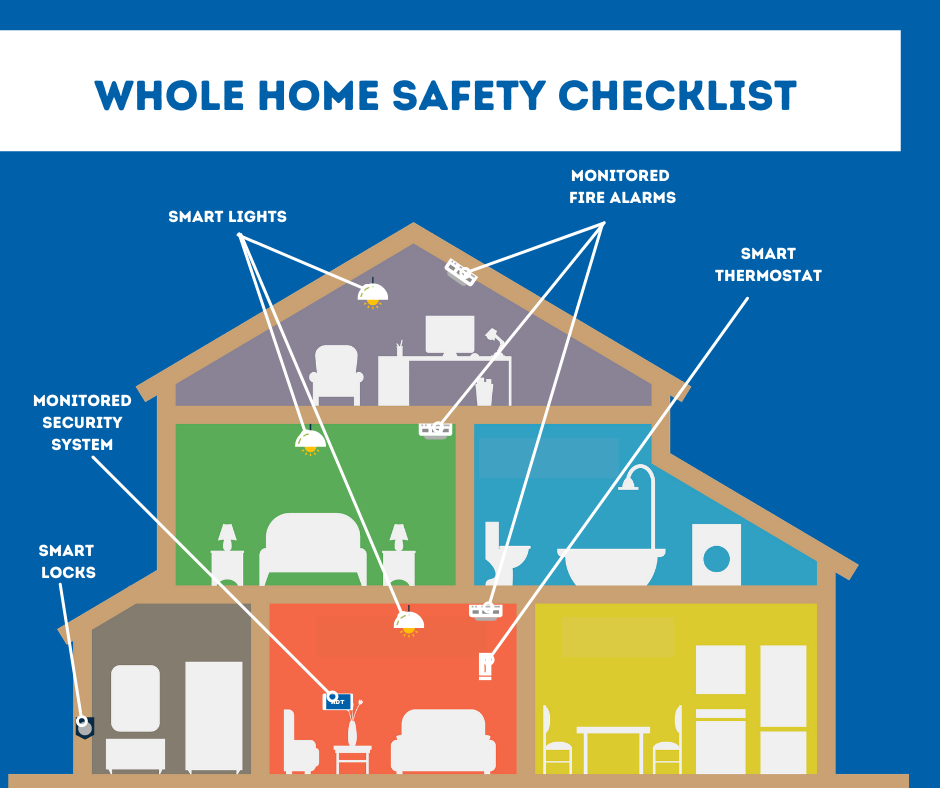
Basic Home Safety Checklist for Denver
While you will want to employ a room-by-room method for home safety, there are a few methods that work for a lot of your rooms. These components can sync with one another through a smart hub, and can even work off other things. You might also control all your home safety devices using a smartphone app, like ADT Control:
-
Monitored Security System: Each one of your windows and doors should have a sensor that alerts you to a break-in. As the alarm goes off, your monitoring agent answers the call and quickly sends a first responder.
-
Smart Lighting For Each Room: Of course, you can schedule your smart bulbs to become more eco-conscience. But they can also allow you to keep safe during an emergency. Have your smart bulbs flip on when a security alarm goes off to scare off robbers or illuminate a path to a secure area.
-
Smart Thermostat: Likewise, a smart thermostat in Denver could save you 10%-15% in utility spending. Also, it can flip on the exhaust fan when your alarms senses a fire.
-
Monitored Fire Detectors: It’s code that you have a fire alarm on each level of your house. You can increase your fire readiness by hanging a monitored fire alarm that detects unusual heat and smoke, and pings your round-the-clock monitoring agents when it thinks that there’s a fire.
-
Smart Lock For Every Door: Every door that needs a keyed lock can use a smart lock. Now you can set numbered codes to each family member and receive alerts to your phone when your locks are activated. Your locks can even automatically open, letting you quickly get out during a fire or dangerous situation.
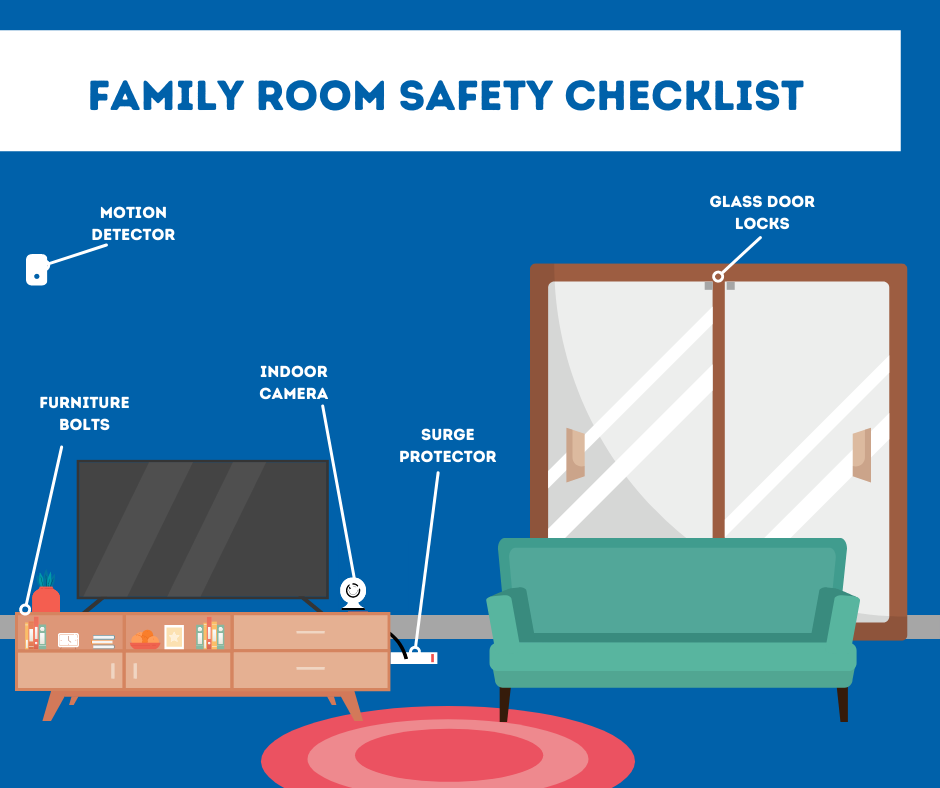
Living Room/Family Room Safety Checklist For Denver
You’ll hang out most in your family room, so it’s the most reasonable area to start your home safety makeover. Highly sought after items, like your TV or stereo system, usually reside in your family room, making it a popular room for thieves. Start with hanging a motion sensor or indoor security camera by the doorway, then try the following suggestions:
-
Motion Detectors: By hanging motion sensors, you’ll hear a loud noise if they sense unusual movement in your family room. You’ll want motion sensors that ignore pets or you’ll get your sirens go off each time your dog passes through for a drink of water.
-
Indoor Security Camera: An indoor security camera offers a visual on your living room. Get constant streams of your room so you can see what’s happening through the mobile app. Or talk with your family in the room with the two-way talk feature.
-
Surge Protector/Outlet Maintenance: Make sure you protect all your electronics and quit overloading your outlets with a surge protector. For added energy-efficiency, install a smart plug with anti-surge functionality in the unit.
-
Entertainment Center Secured To The Wall: If you have any small children, you’ll need to bolt your entertainment center or other heavy furniture to the wall. This is especially important if your family room has carpeting that might make objects extra unstable.
-
Enhanced Locks For Sliding Glass Doors: If your family room uses a glass door that opens to a deck, patio, or porch, you get that the lock is usually flimsy. Use a custom lock, like a metal bar or small locks that bolt to the top and bottom of the frame.
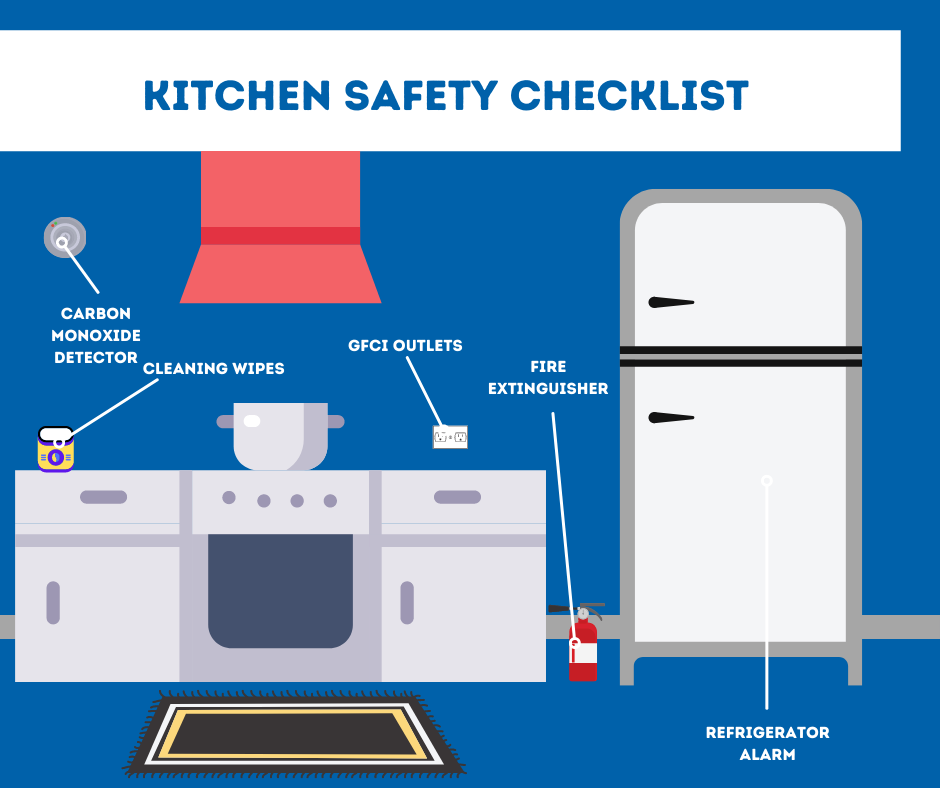
Kitchen Safety Checklist For Denver
Your kitchen has room for items that can provide safety to your home. Most of these objects should be easy to add and can be purchased from the grocery store:
-
Fire Extinguisher: A fire can come from from an unwatched frying pan or a towel that’s too close to a burner. Always store a fire extinguisher at hand for any stove or oven emergencies.
-
Circuit Interrupter Box On Every Outlet: A circuit interrupter outlet should be installed anywhere they’re close to running water to prevent electrocution. That means the plugs by your sink and kitchen counter. Since the late ‘80s, it’s been standard to have one GFCI per dedicated circuit. But each one of your plugs will flip off if any outlet senses a surge, so you’re going to want to install a separate GFCI for every outlet.
-
Monitored CO Detector: A carbon monoxide detector is handy in kitchens that have a gas oven and range. If your gas appliances leak, the carbon monoxide detector will play a high-decibel noise and contact your monitoring agent.
-
Clorox Wipes Or Spray: The biggest safety issue in the kitchen is the invisible bacteria and contamination from blood from meat and other foods. Always keep antiviral wipes or an antibacterial spray to scrub off your area before and after making a meal.
-
Freezer and Refrigerator Alarm: The milk, meat, and perishables in the refrigerator need to remain at a cold temperature to be ready to consume. If you leave the freezer or refrigerator door open too long, then a constant beep will tell you to close the door. Some refrigerators already have an alarm, others don’t, and you’ll have to get an external alarm from the hardware store.
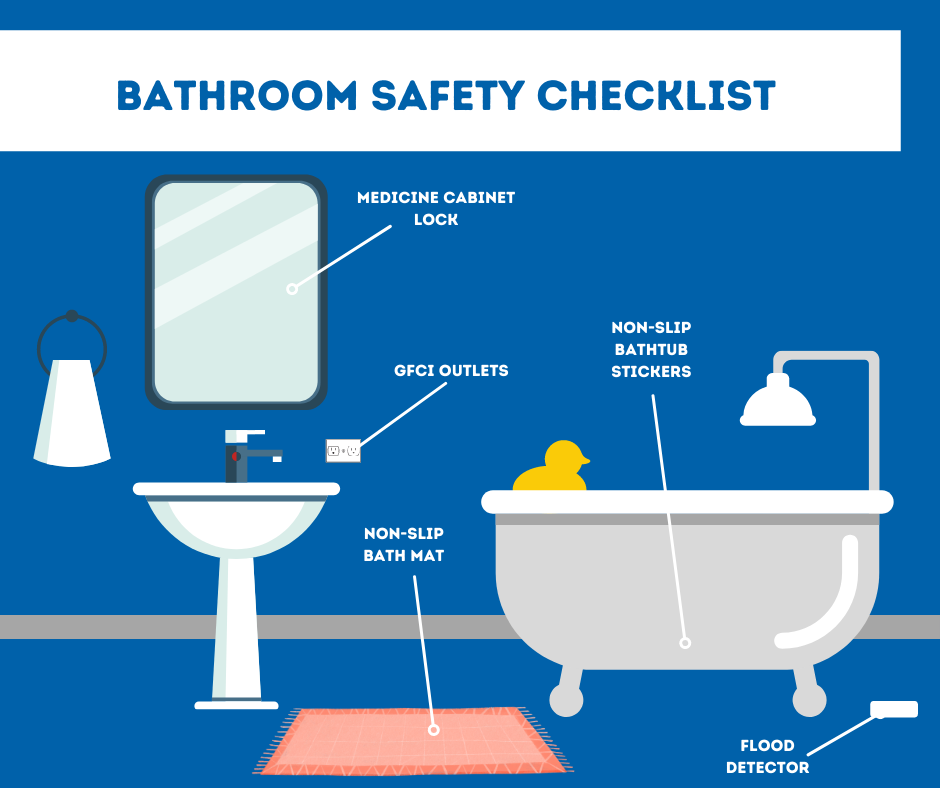
Bathroom Safety Checklist For Denver
Just because you may not have a bunch of room in your bathroom there’s still safety hazards. From flood detectors to medicine care, here are five safety tips for your bathroom:
-
Flood Detectors: A leaking sink or tub can create extensive water damage. Find out early about pooling water with a flood detector and save the time and money from renovations.
-
No-slip Shower Mats: A fall in the bathroom can be devastating, causing cuts, bruises, or trips to the hospital. You can prevent these issues with a non-slip bath mat for your wet feet.
-
Textured Bathtub Stickies: Likewise, a tub basin can be a slick area to move in. Make sure every has some textured stickies so your toes have a bumpy patch to grip.
-
Medicine Door Lock: If you have young children or anyone with memory complications, you need to take additional care regarding medicine. Secure your bottles by installing a medicine cabinet with a locking latch.
-
GFCI Circuits: Just like the kitchen, you should also use a surge protecting circuit interrupter outlet on each bathroom receptacle. This will shut off the electric current if they ever get wet or you have a sudden spike from an electric razor or hair dryer.
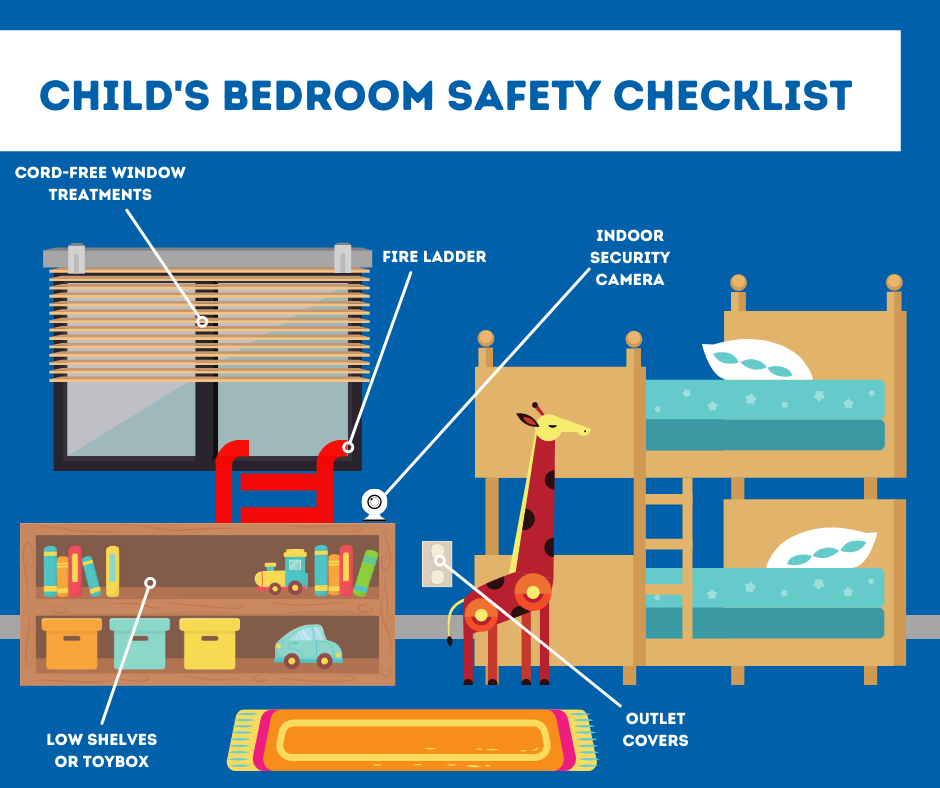
Children’s Bedroom Safety Checklist For Denver
Your kid’s bedroom should balance safety with simplicity. If their window shades or other items are safe but difficult to operate, then your children may perform unsafe activities -- like climb a dresser -- to touch them. Here are some straightforward, and safe, ideas:
-
Cord-Free Window Treatments: Safety professionals have long called corded window treatments an unsuspecting problem for children and animals. Install motorized blinds or shades that kids can easily open and close with a remote. Or go state-of-the-art and link your shades to your security system so they rise without anyone’s help when the sun comes up, and close at night for an easier sleep.
-
Indoor Security Camera: An indoor security camera sitting on your toddler’s desk can act like a baby monitor that you can watch with your phone. And if they want something, they can use the 2-way talk button on the camera.
-
Outlet Plug Covers: While every outlet should use covers on them to protect your little children, this is doubly needed in their bedroom. It’s the one room in your home where your toddler will most likely hang out solo without constant adult supervision.
-
Window Fire Ladder: If you have bedrooms on the second story, then you will want to have a window escape ladder. These can let a child escape even if the stairway or ground floor are engulfed in smoke and fire. Just remember to go over how to employ them one or two times a year.
-
Toy Chest Or Low Bookshelves: It’s strange to view a toy chest as a safety item, but you’ll understand if you’ve ever walked on an action figure in your socked feet. A clean floor let your child have a quick escape when there’s a safety or security event.
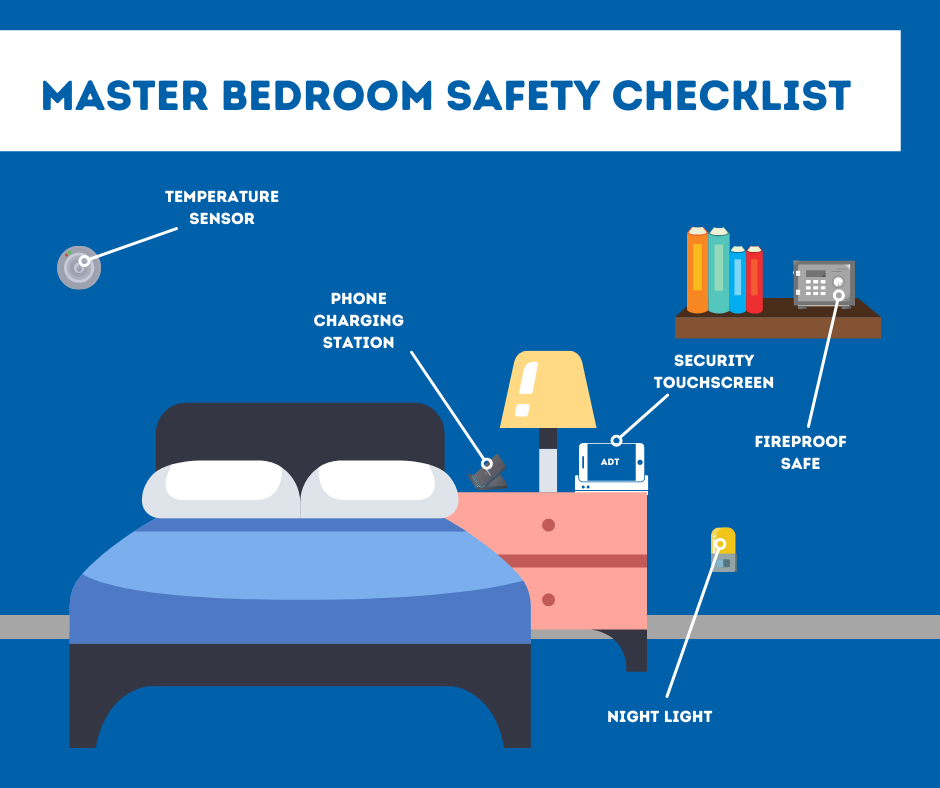
Master Bedroom Safety Checklist For Denver
Your master bedroom should be your calm space, so let your safety components make life easier when there's an emergency event. After all, being jerked awake by a wailing siren can be quite a shock.
-
Home Security Touchscreen: Having a touchscreen on your dresser lets you see what’s what that noise was without jumping out of bed. You could always turn on your ADT phone app. However, the large touchscreen may be easier to manage to use when you’re yawning and finding your bearings.
-
Device Charging Area: We rely on our phones for so much now alarm clocks, internet searches, social media, and sometimes even phones. The only problem is that an uncharged cell in the middle of the night cuts us off from the outside world if during an emergency. To keep it nice and ready, a charging station or cord becomes should be used nightly.
-
Nightlights Or Voice Activated Smart Lights: A plug-in light helps ground you when you’re jolted awake from a fire alarm or other sounds. If you have trouble falling asleep with a nightlight, use smart lights in your fixtures. Then you can have light anytime with a push of a button or vocal command.
-
Fireproof Lockbox: Store your essential paperwork like social security cards, stock certificates, or banking information in a fireproof safe. Your lockbox can be a bigger one that camps out in a corner or a smaller handheld safe that you can snatch on your way out during a fire or break-in.
-
Temperature Sensor: The drawback with most bedrooms is that they tend to be too stuffy or be chilly because they sit far from the thermostat. A temperature sensor can talk to your smart thermostat so you will have a pleasant, restful sleep at just the right temperature.
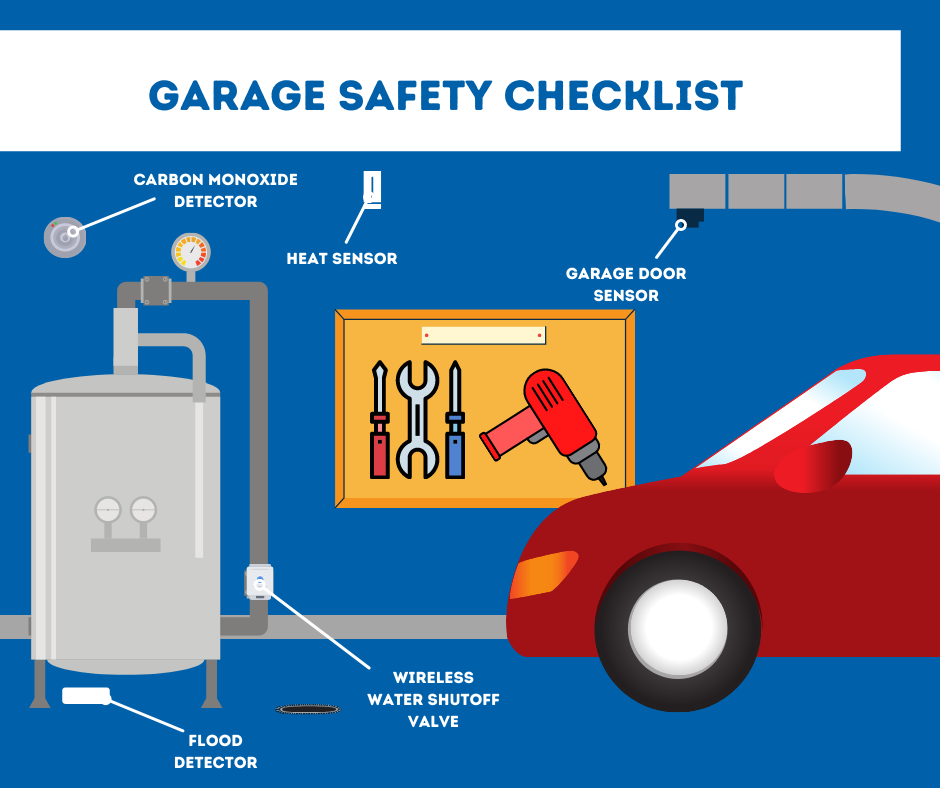
Garage/Basement Safety Checklist For Denver
Most safety needs in the basement or garage deal with your water heater or heating system. Seeing issues before they start can prevent larger emergencies later on. So, as you take a look around your storage areas, check over these safety items:
-
Water Detector Or Sump Pump Alarm: Putting a flood sensor by your water heater or sump pump can stop you from discovering a mess when you go into your garage or basement. The last you need is to waste the weekend bailing out water and going through all those soggy boxes.
-
CO Detector: It’s beneficial to install a carbon monoxide alarm in a place where a gas leak can occur. If you use gas heat, you’ll want to install an alarm in the same room as your inbound pipes.
-
Remote Water Shutoff Valve: If your water detector finds a plumbing leak or a busted pipe, then you will want to shut off the main water line immediately. With a WiFi shutoff valve, you can block water flow from your phone. That’s helpful when you’re visiting relatives and get an emergency leak text on your phone.
-
Garage Door Sensor: Leaving the garage up causes all types of problems. You can lose heat through that gaping hole, and rodents or lurkers can just walk in. A sensor will notify you about a forgotten garage door and lets you close it with your phone.
-
Temperature Sensor: A heat sensor in your basement or garage is a definite if you wonder about your pipes freezing. The temperature in these rooms can be surprisingly different than the main part of the home, so you will want to maintain a close look on them through your security mobile app.
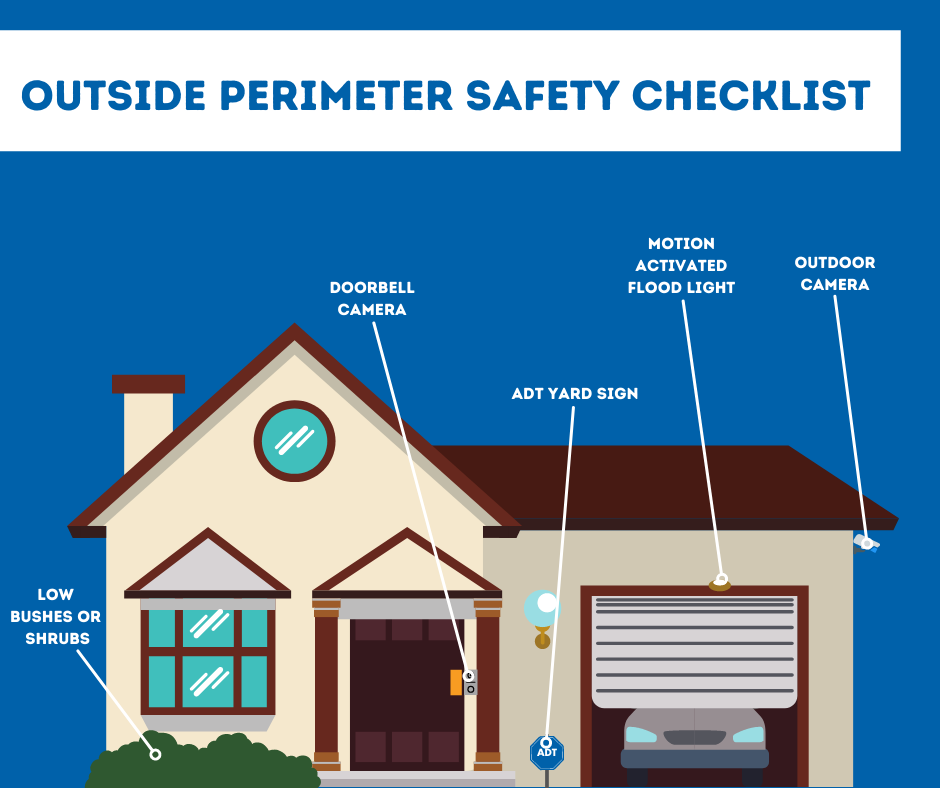
Home Perimeter Safety Checklist for Denver
Your yard, driveway, and front porch are just as crucial to make safe as the rest of your home. Use this checklist to defend your perimeter:
-
Doorbell Security Camera: See who’s arrived at the front door before you open it and talk to visitors. View deliveries and look at video clips if they are stolen.
-
Outdoor Security Camera: You can hang outdoor cameras to alert you to unusual movement in your yard. These devices come in handy in areas where you might not have a window -- like around a cellar or by the driveway.
-
Window Height Shrubbery: High bushes can create some serenity, but they also hinder your view of the outside. Don’t offer potential burglars an area to hide. Plus, high bushes or trees against your home can obstruct gutters and summon pests.
-
ADT Signage: One of the largest disincentives for a thief is telling aspiring intruders that you have a state-of-the-art security system. An ADT sign by the front door and a window cling will show ne'er-do-wells that they might want to shove off to an less prepared score.
-
Motion Controlled Porch Light Fixtures: Light is the best obstacle to people who sneak around in the unlit places. Motion-activated flood lights on your deck, porch, or garage can frighten possible intruders away. They also help you work the locks when you arrive to the house on those dark, winter nights.
Contact Secure24 Alarm Systems To Help You With Your Home Safety Checklist for Denver
While Secure24 Alarm Systems can’t deliver every item on your Denver home safety checklist, we can discuss a state-of-the-art security system. With everything from alarms to thermostats, we can customize the ideal system for your family’s needs. Just call (720) 465-2917 to get started or complete the form below. Or personalize your own solution with our Security System Designer.
